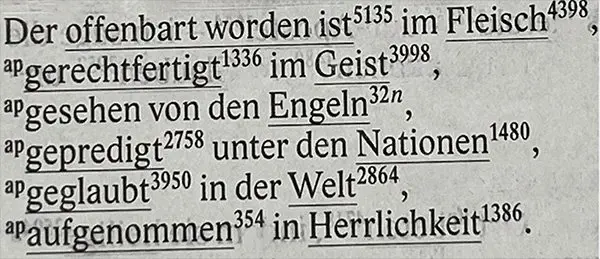The controversy surrounding 1 Timothy 3:16
The verse 1 Timothy 3:16 is a key text of the New Testament that is often cited in the context of the doctrine of the Trinity. In textual history, however, this verse has several readings that mainly differ in one word: Either it reads “God” (Theos) or “He” (Hos) in the phrase “manifested in the flesh.” For example, in the King James Version, the wording “And without controversy great is the mystery of godliness: God was manifest in the flesh” is used, which relies on the reading “Θεὸς” (Theos, “God”). In contrast, more modern translations like the New Revised Standard Version often use the wording “Without any doubt, the mystery of our religion is great: He was revealed in flesh,” which is based on the reading “ὃς” (Hos, “He”).
These different readings have significant implications for the interpretation and meaning of the verse. Is it “God [der] was manifested in the flesh” or is it “He who [er/sie/es] was manifested in the flesh”?
Luther 1984
“And confessedly great is the mystery of faith: God was manifested in the flesh”
"And undoubtedly great is the mystery of faith: He was manifested in the flesh."
“Beyond all question, the mystery of our faith is great: He appeared in the flesh.”
or Elberfelder:

Text Variants for 1 Timothy 3:16: A Detailed Analysis of the Manuscripts
Let’s start by clarifying the key terms:
- Palimpsest: A manuscript where the original text has been scraped off and replaced by a new text.
- Uncial Codex: A manuscript written in capital letters.
- Minuscules: Manuscripts in small letters.
Now onto the readings:
“Θεὸς” (Theos, “God”)
This reading is found in a number of documents:
- Codex Ephraemi Rescriptus (C): Dating to the 5th century. A palimpsest known for its particular complexity in text reconstruction. It is preserved in the Bibliothèque nationale de France.
- Byzantine manuscripts: Predominantly dated to the Middle Ages. These manuscripts form the basis for the Textus Receptus. They originated in a context where the Trinity was already firmly established as a theological dogma. Their reading has strongly influenced the Trinitarian interpretation and is used in most modern translations based on the Textus Receptus.
- Minuscules: These manuscripts are also mostly medieval and follow the Byzantine textual type. They tend to preserve the traditional Byzantine textual form.
“ὃς” (Hos, “He”)
This reading is found in older manuscripts that are considered more reliable textual witnesses:
- Codex Sinaiticus (א): An uncial codex from the 4th century, considered one of the oldest and most reliable textual witnesses. Parts of this codex are located in various libraries worldwide.
- Codex Alexandrinus (A): Another uncial codex, dated to the 4th or 5th century. It is preserved in the British Museum and contains both the Old and New Testaments. Both of these older manuscripts are often considered more reliable by textual critics as they are closer to the original text and use the reading “ὃς” (Hos, “He”).
“ὅ” (Ho, “which”)
This reading is significantly less common:
- Codex Claromontanus (D): An uncial codex from the 6th century, preserved in the Bibliothèque nationale de France. It is primarily used for the Epistle to the Galatians by Paul and plays a minor role in textual criticism discussions.
Conclusion
The reading “Θεὸς” (Theos, “God”) is primarily found in later Byzantine manuscripts and in the Textus Receptus. The reading “ὃς” (Hos, “He”), on the other hand, appears in older manuscripts considered more reliable. The reading “ὅ” (Ho, “which”) is the rarest and is mainly found in Codex Claromontanus.
Scientific Statements
In the world of New Testament textual criticism, 1 Timothy 3:16 serves as a touchstone against which the expertise of scholars is measured. Before delving into the depths of this academic discipline, it is worth noting that older manuscripts such as the Codex Sinaiticus and the Codex Alexandrinus – highly esteemed witnesses from the 4th or 4th or 5th century — favor a specific reading: “ὃς” (Hos, “He”). This preference forms a backdrop against which the views of renowned textual critics become particularly relevant.
In academic discourse, there is a clear preference for the older manuscripts. Bruce Metzger, one of the leading textual critics of the 20th century, notes: “In view of the scribes’ tendency to replace ordinary words with synonyms, it becomes clear that ‘ὃς'[Hos] is the earliest possible word choice of the text” (“A Textual Commentary on the Greek New Testament”, Deutsche Bibelgesellschaft: Stuttgart 1994). This underscores the tendency to consider the older reading as more authentic.
Bart D. Ehrman, another prominent textual critic, states: “The most likely scenario is that later scribes, recognizing that the passage could be read as affirming the divinity of Christ, changed ‘which was’ to ‘God’ to make the identification explicit” (“The Orthodox Corruption of Scripture”, Oxford University Press: 1993). This statement implies that the reading “Θεὸς” could be a deliberate textual modification.
The preference for “ὃς” is also shared by other sources. Kurt and Barbara Aland, renowned for their work on the “Nestle-Aland Novum Testamentum Graece,” emphasize the importance of the older manuscripts (“The Text of the New Testament”, William B. Eerdmans Publishing Company: 1995). Michael W. Holmes, editor of the “SBL Greek New Testament,” holds a similar view (“The SBL Greek New Testament”, Society of Biblical Literature: 2010).
The consistency of these academic opinions, favoring the older manuscripts and the reading “ὃς,” suggests that this reading is closer to the original text.
Trinitarian Preferences and Textual Accuracy: A Critical Look at the Reading "Θεὸς" in 1 Timothy 3:16
Die byzantinischen Handschriften und der Textus Receptus, die vorwiegend die Lesart “Θεὸς” (Theos, “Gott”) verwenden, entstanden in einer Ära und einem geografischen Raum, in dem die trinitarische Doktrin bereits tief in die theologische Landschaft eingebettet war.Trinitarian Preferences and Textual Accuracy: A Critical Look at the Reading “Θεὸς” in 1 Timothy 3:16 Several factors underscore this observation:
- Byzantine Empire: The dominance of Orthodox Christian theology in this empire created an environment where the Trinity was not only accepted but considered an essential element of Christian identity.
- Textus Receptus: This textual basis is interesting in that it allowed the theology of the time, including the Trinity, to influence the text of the New Testament. The Textus Receptus was compiled more than a thousand years after the early Christian centuries and during a time when the Trinity was already firmly established through councils and church fathers.
- Medieval Scholasticism: Works by theologians such as Thomas Aquinas provide a rich reservoir of Trinitarian thoughts that could have influenced the Byzantine scribes and editors of the Textus Receptus.
Conclusion
The temporal and geographical proximity of these texts to a Trinitarian culture makes it plausible that the reading “Θεὸς” (Theos, “God”) was not only a textual-critical choice but also a theological one. The scribes and editors may have chosen this reading not necessarily because it represents the original text, but because it supports an established theological view. If the question of accuracy and fidelity to the original text is paramount, then the older manuscripts that use the reading “ὃς” (Hos, “the one who”) deserve special attention. They move closer to the original understanding of the text and contain fewer anachronistic theological influences.







